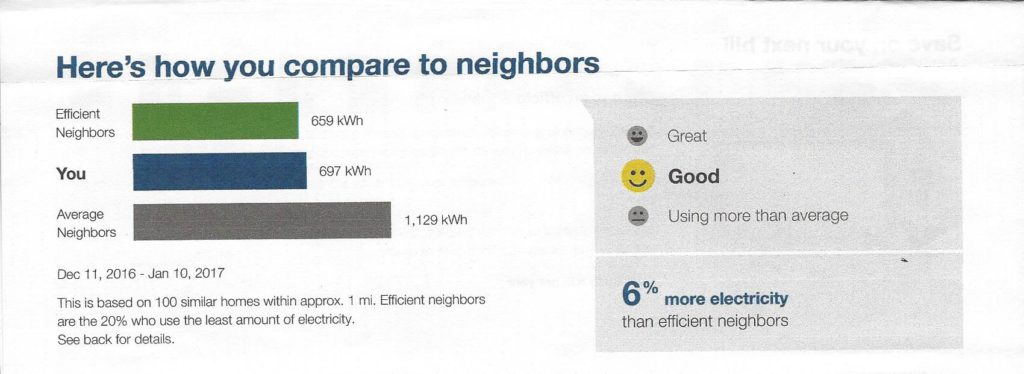Electric utility companies promoting power conservation programs discovered that simply informing consumers of their electricity usage relative to their neighbors lowered overall consumption. This type of normative social comparison has produced the same effects in other domains. Why does this work? How can the idea be used in Customer Success?
Keeping up with the Joneses
Homeowners typically receive letters from the power company showi ng how many kilowatt hours they’ve used over the past month compared with other homes in the vicinity. In addition to bar charts, consumers see a “smiley face” if they’re doing well or a “frowny face” if they’re trailing the average. The mailers typically also include a list of recommendations for conserving energy.
ng how many kilowatt hours they’ve used over the past month compared with other homes in the vicinity. In addition to bar charts, consumers see a “smiley face” if they’re doing well or a “frowny face” if they’re trailing the average. The mailers typically also include a list of recommendations for conserving energy.
Surprisingly, this simple trick works. People change their behaviors when they see how they stack up against others. In multiple experiments run by the utility companies, providing benchmarks reduced overall power usage 2%.[1] That may not sound like much, but across millions of homes the savings are substantial, helping power companies meet their government-mandated conservation goals. Similar outcomes from communicating descriptive norms have been shown in hospitality (reusing towels more often),[2] voting (increasing turnout),[3] and charitable giving (boosting the number of donors).[4]
What causes this behavior? Neuroscientist David Rock says subconscious social drivers are hardwired into our brains after eons of evolution.[5] One primary driver is status, how we view ourselves in the “pecking order.” Social bearing means survival—whether it’s humans, birds, or wildebeest, members at the apex of the hierarchy are more likely to continue living and pass along genetic information. To aid our preservation, we reflexively perceive higher status as a reward and lower status as a threat. As a result, we savor outranking others and become anxious when we fall short.
Seeing rank expressed in numbers may increase the urgency to act. Neuroscientists have found that the brain uses the same circuitry to process number comparisons as it does to determine social status.[6] The findings suggest we subconsciously use numbers to record social rank, and seeing status expressed numerically activates overlapping neural networks that may add fuel to our emotional response. Whenever emotions are strong, decisions and actions tend to follow.
Better business reviews
 Many Customer Success Managers (CSMs) at Software-as-a-Service (SaaS) companies conduct Quarterly Business Reviews (QBRs) with senior executives at key accounts. Customers derive business value from deploying and using software, so a common objective is to ensure implementation milestones and adoption goals are met. Executive engagement and attendance at QBRs, however, is a chronic problem. Often CSMs do a poor job of describing how the software subscription impacts things like organizational productivity and decision making, but other times they simply fail to capture the attention of senior leaders.
Many Customer Success Managers (CSMs) at Software-as-a-Service (SaaS) companies conduct Quarterly Business Reviews (QBRs) with senior executives at key accounts. Customers derive business value from deploying and using software, so a common objective is to ensure implementation milestones and adoption goals are met. Executive engagement and attendance at QBRs, however, is a chronic problem. Often CSMs do a poor job of describing how the software subscription impacts things like organizational productivity and decision making, but other times they simply fail to capture the attention of senior leaders.
Showing comparative data can help. Besides demonstrating progress vs. the customer’s goals, showing results relative to the customer’s own peer groups has greater impact. Executives are usually competitive people. When they see their organization is ahead of the pack, the fact suddenly becomes a talking point with their own bosses. When they see progress is behind the curve, they are more likely to push subordinates and make things happen. Sharing the tidbit garners increased attention and raises CSM status in the eyes of executives. “Information is power” is also true among top managers, and good intelligence is always appreciated.
The approach works at scale, too. Like the power company, automatically communicating descriptive social norms can move the needle in large populations of small customers. When SaaS companies show individual performance relative to benchmarks via tailored e-mails and in-product messages, they can influence behaviors in mass audiences without the need for personal contact. A simple change in how data are communicated can bump customer usage as well as CSM productivity.
We’re naturally wired to compare ourselves with others. SaaS companies can easily capitalize on this basic human nature. And that would place them ahead of the pack.
Sources:
[1] Alcott, H. (2011). Social norms and energy conservation. Journal of Public Economics 95, pp. 1082-1095
[2] Nolan, J., Schultz, W., Cialdini, R., Goldstein, N., Griskevicius, V. (2008). Normative influence is underdetected. Personality and Social Psychology Bulletin 34, pp. 913-923
[3] Gerber, A. and Rogers, T. (2009). Descriptive social norms and motivation to vote: everybody’s voting and so should you. The Journal of Politics 71, January 2009, pp. 178-191
[4] Frey, B., and Meier, S. (2004). Social comparisons and pro-social behavior: testing “conditional cooperation” in a field experiment. The American Economic Review, December 2004, pp. 1717-1722
[5] Rock, D. (2008). SCARF: a brain-based model for collaborating with and influencing others. NeuroLeadership Journal
[6] Chiaoa, J., Haradaa, T., Obyb, E., Lia, Z., Parrish, T. Bridge, D. (2008). Neural representations of social status hierarchy in human inferior parietal cortex. Frontiers in Neuroscience.
